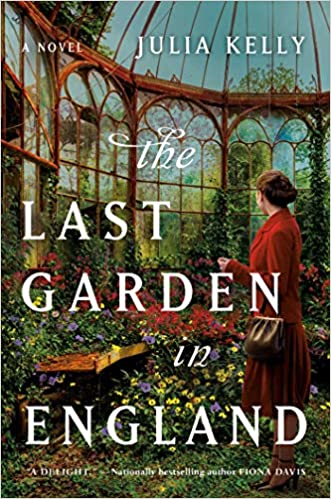The Last Garden in England by Julia Kelly
Reviewed by Marcia Allen
Collection Services Manager, Manhattan Public Library
 “The Last Garden in England” is a lovely piece of historical fiction that moves smoothly among three different time periods. The opening section, which takes place in February of 2021, concerns Emma Lovell, who has been hired to restore a neglected estate garden to its former glory. Emma, who runs her own gardening business, yearns to see designs of the original garden so she can plan similar layouts for the owners. When the owners do locate some of the original plans, they also uncover a mysterious past involving the locked Celeste’s garden, also referred to as the winter garden. It will be up to Emma and her clients to learn more about this secluded section of the garden and its neglected plantings. There might also be a beginning of romance for restorer Emma, who feels she doesn’t really have time for love and who might take a position with the Royal Botanical Heritage Society.
“The Last Garden in England” is a lovely piece of historical fiction that moves smoothly among three different time periods. The opening section, which takes place in February of 2021, concerns Emma Lovell, who has been hired to restore a neglected estate garden to its former glory. Emma, who runs her own gardening business, yearns to see designs of the original garden so she can plan similar layouts for the owners. When the owners do locate some of the original plans, they also uncover a mysterious past involving the locked Celeste’s garden, also referred to as the winter garden. It will be up to Emma and her clients to learn more about this secluded section of the garden and its neglected plantings. There might also be a beginning of romance for restorer Emma, who feels she doesn’t really have time for love and who might take a position with the Royal Botanical Heritage Society.
The second section of the book tells of Venetia Smith who designs the original garden in 1907. Hers is a radical plan, with separate garden spaces for separate purposes. She creates, for example, a lively and colorful area designed especially for the children who live here. She creates another area that is exceptionally suited for afternoon tea. She also adds Celeste’s garden, dedicated to a mysterious person. Venetia, a highly qualified designer, seeks also to have women admitted to the Royal Botanical Heritage Society, and she dearly wants to maintain her own independence. When she meets the brother of the estate’s owner, their mutual attraction becomes a threat to the British class system of the early 1900s.
The final section describes the artistry of Beth Pedley who loves both the estate and its formal gardens in 1944. When she becomes a “land girl” who volunteers as a farmhand during World War II, she has already agreed to be spoken for by Colin, a childhood friend who intends to marry her when he returns from war. A chance encounter with a wounded serviceman, however, could change her plans. In the meantime, she creates some outstanding sketches of the various gardens around the estate.
This final section is complicated further by the estate’s landowner. A recent widow, Diana Symonds, is very uncomfortable with the estate being converted to a hospital for wounded servicemen, and she is saddened when her sweeping lawn must be given over to grow food supplies. Her young son, Robin, is lively little guy who is thrilled to gain a new playmate when the cook’s nephew comes to live at the estate. Diana has a talent for relating to young children, a talent that will help her get through a time of profound heartbreak.
Confused by the time shifts? The beauty of those returning periods is in the revelations that each contains. We witness Emma’s dread of her mother’s criticism when she “refuses to get a real job.” We sympathize with Venetia’s realization that the owners of the estate in 1907 consider her inferior. We come to understand Beth’s reluctance to disappoint her first suitor who is off fighting in the war. Each of these three main characters is made more complex, more human, by those passages that bring us back to specific time periods.
Equally fascinating is the creation, the decay, and the restoration of the gardens. Author Kelly clearly knows a great deal about specific plants and designs, and invites us to visualize the work that goes into distinct layouts. Against this backdrop, we see the interactions, the conflicts, and the tragedies that the characters experience. Thus, we have historical fiction, romance, and mystery all brought together in a well-written story. This captivating book will appeal to many different audiences.

